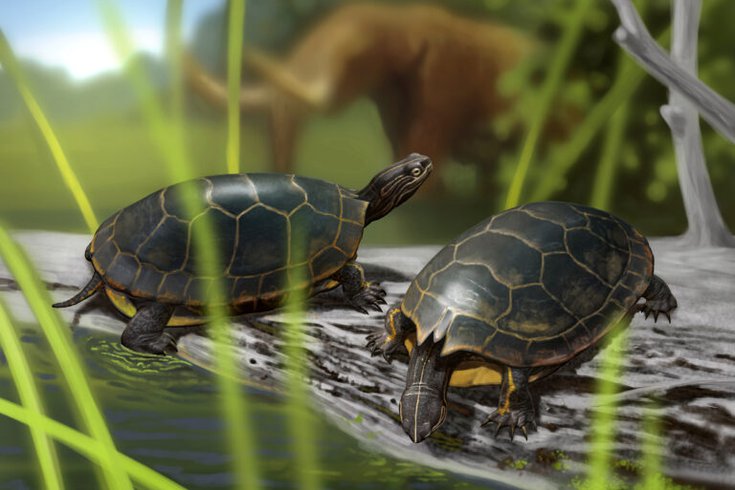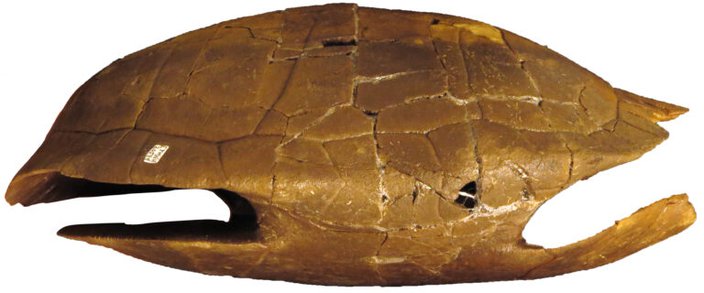
January 17, 2023
 Provided Image/Harrisburg University of Science & Technology
Provided Image/Harrisburg University of Science & Technology
Fossils of an extinct and previously unknown species of painted turtle were discovered in eastern Tennessee. The fossil was found and determined to be a new species by Harrisburg University professor Steven Jasinski.
An environmental scientist at Harrisburg University recently found the shell of an extinct, previously unknown turtle species at a fossil site in Tennessee.
The discovery of the painted turtle – which is estimated to be 5 million years old and has since been given the scientific name Chrysemys corniculata – happened at the Gray Fossil Site, an area with a preserved sink-hole pond dating back to the ancient Early Pliocene period. It was once the habitat to mastodons, rhinos, red pandas and a range of other species, many of them extinct.
The Harrisburg University scientist, Steven Jasinski, found well-preserved turtle shells that had distinct, horn-like points at the end where the reptile's neck would have protruded. The horns are similar to those found on present day male painted turtles, the most widespread native turtle in North America.
"A big difference in Chrysemys corniculata is that the 'horns' are present in both sexes, although they appear to be larger in males," said Jasinski, who had studied at East Tennessee State University's paleontology program, which manages the Gray Fossil Site "It is likely they were sexual display features."
Painted turtles are believed have existed as long ago as 35 million years based on existing fossil evidence. Jasinski believes the horned ancestor of the modern painted turtle may have fared better in a different climate.
"Chrysemys corniculata may have preferred slightly warmer temperatures," said Jasinski. "As conditions changed, C. picta (modern painted turtles) were potentially able to overtake the other species, making them the most widespread turtles in modern North America."
 Provided Image/Harrisburg University of Science & Technology
Provided Image/Harrisburg University of Science & TechnologyAnother view of the Chrysemys corniculata shell.
 Provided Image/Harrisburg University of Science & Technology
Provided Image/Harrisburg University of Science & TechnologyA fossil shell from a 'horned painted turtle,' called Chrysemys corniculata.
The Gray Fossil Site was discovered accidentally in 2000, when a construction crew with the Tennessee Department of Transportation, working on an infrastructure project, found black clay and began unearth fossils. The fossils were analyzed by scientists, who soon recognized the significance of the site and worked with state officials to build a museum and preserve that opened in 2007.
Scientists believe the Gray Fossil Site formed about 5 million years ago from sinkhole that opened in the limestone there. Over time, the hole filled with water, creating a pond that was surrounded by forest. Sediments gradually filled the pond, burying plants and animals whose fossils have since been found through excavation. In the Appalachian Highlands, the site is one of the only known fossil locations from the Miocene-Pliocene periods — which ocurred about 5 to 4.5 million years ago.
More than 100 species of ancient animals have been found at the site, including the only fossilized red panda found in the Americas and the oldest known fossilized wolverine.
The pond where Chrysemys corniculata lived also was home to other turtle species, such as slider turtles and snapping turtles. In modern times, there are about 350 turtle species on Earth. They dwell on land and in both salt and freshwater environments, spanning every continent except Antarctica. Most species are in North America and South Asia.
Jasinski previously discovered another slider turtle species at the Gray Fossil Site, which so far has turned up three previously unknown varieties of turtles.
"The Gray Fossil Site is home to at least eight species of turtles," Jasinski said. "It is an amazingly unique fossil site and important for our understanding of turtle evolution at a unique place and time."
Jasinski added that climate changes historically impact the way turtle species have evolved, and that warmer temperatures could put painted turtles at risk. His findings were published in the Zoological Journal of the Linnean Society in November.
"While painted turtles aren't endangered today, this study suggests that they may eventually follow the path of other turtles that are already having a hard time dealing with conditions today," Jasinski said. "I only hope this can be another potential call to be proactive for conservation rather than reactive, because if we continue to wait for more turtles to become endangered, it may be too late."